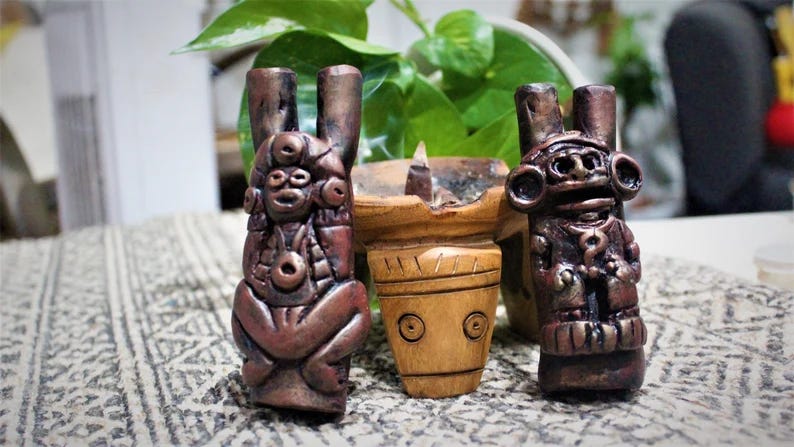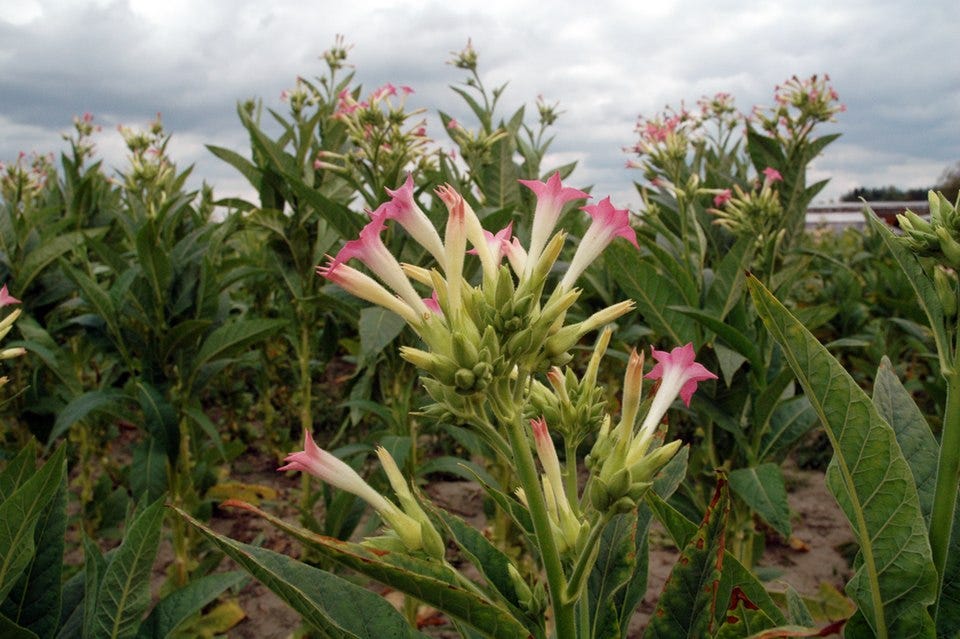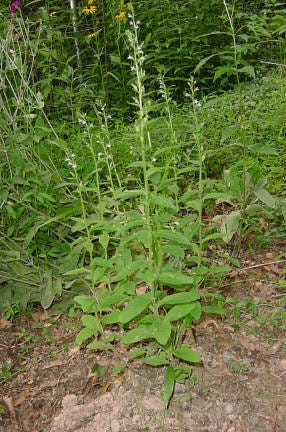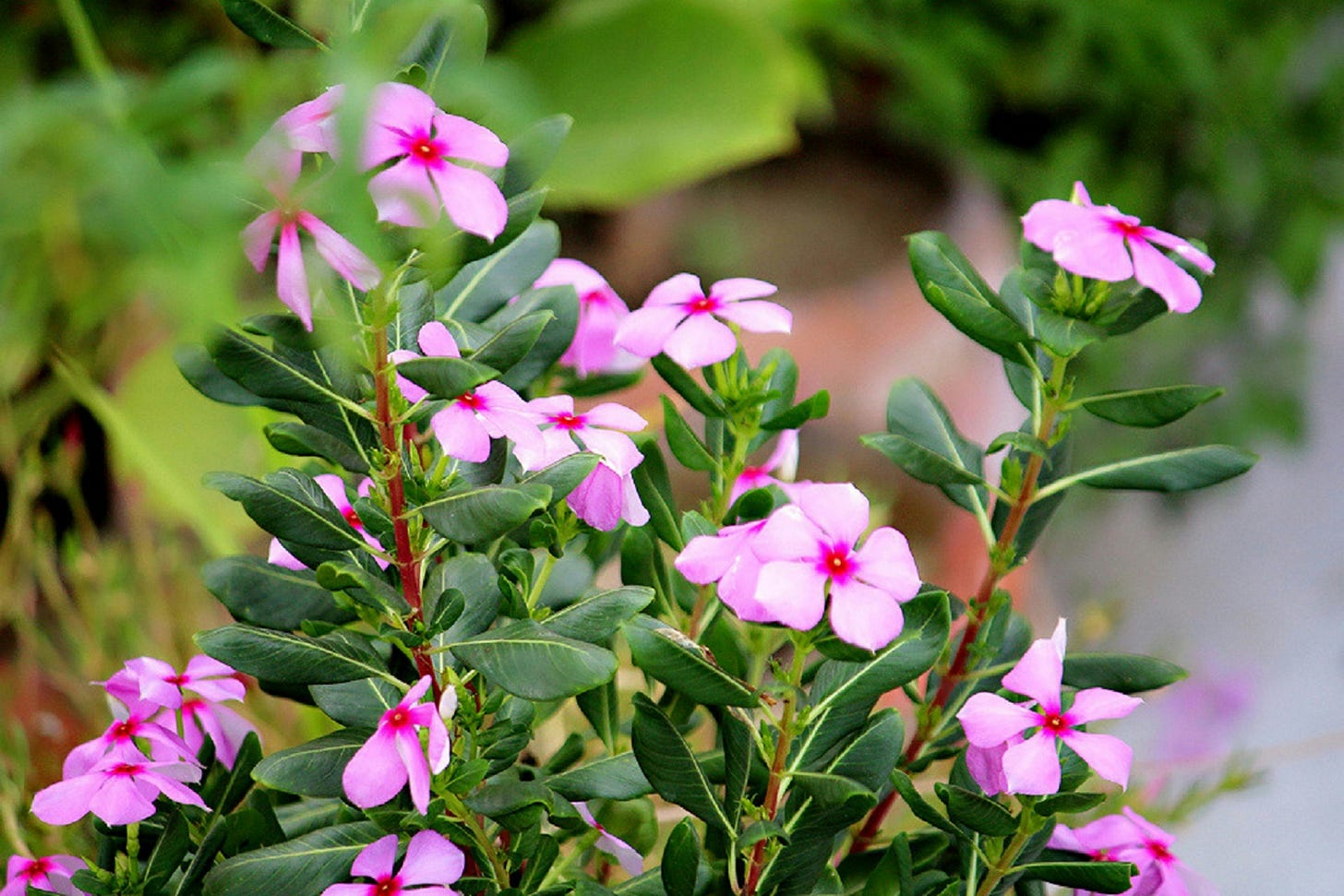ALSO KNOWN AS: Nicotiana tabacum, petum, betum, cogioba, cohobba, quauhyetl, picietl or yietl, henbane of Peru
From a distance
Lovely pink and white flowers like small explosions
Large leathery leaves billowing around their stems
Known as the soul
One of the top killers of people in the world, yes.
One of the first cultivated plants in the world
In the days of dreaming and unseriousness, when I was old enough to and young enough to not care about consequences I remember, before anything, the smoke.
Every single cigarette was a ritual.
I became compatriots with all sorts of people while smoking cigarettes. I found calm and courage. I became someone else while smoking a cigarette: a character in a movie, a spirit, a goddess, a ghost, part wild. The smoke surrounded me and I found another version of myself. The way my fingers held the cigarette, and ashed it. I wore a cultural habit of a woman who smokes. This felt liberating and rebellious. While smoking, I felt supported and grounded by the act, my identity not torn away, but more certain while I was with this - what felt like such an easy drug to love.
In the aftermath, pale, almost green, I purged cigarettes for days. Poisoned by nicotine.
The Soul of Transformation
I could reach out my hand and dance with a tobacco plant, in a dance with death -- they don’t get much taller than me.
It has big floppy ovate, heart, or almond shaped leaves that are whorled and light green around the stem. The leaves have the highest concentration of nicotine, which is brought up through the root. The leaves look weathered like elephant ears, and they can get as tall as a human, just about, five feet or so, with a wide, two foot long base. It is a perennial that grows tall throughout the summer season.
The first year leaves are long and provide a basal nest - a rosette, flourishing around the top of the soil. The plant will transform depending on if it is in the sun or shade. Shade will draw out the dark green in the leaves and they will become wider. If the plant is in the sun it will grow tall and retain its brilliant chartreuse tone.
The small flowers have a sweet and animal scent: slightly alive. They emerge from the top of the plant like a round of trumpets ending in five pointed stars.
Not much is known about the origins of tobacco. Though many speculate that, older than any foods or textiles, tobacco is the oldest cultivated plant in the Americas. Likely it is from southern Bolivia and Northern Argentina and is a combination of two Nicotiana species, Nicotiana sylevestris, and Nicotiana tomentosiformis back from around 5000 BC. Even though there are ancient origins of tobacco use in the Amazon, there are some studies that found tobacco seeds in what is now Utah many thousands of years ago.
The spiritual connection with tobacco is easy to make on the outset — it’s addictive. It kills 8 million people per year, the largest epidemic in history, according to the WHO.
Nicotine is in all nightshade or Solanaceae plants: the tomato to the eggplant, and the potato. They all have alkaloids, but tobacco is the one with nicotine rivers coursing through it.
The alkaloid, nicotine, is only one of 4,000 chemicals that tobacco contains and emits when it is smoked. It touches every organ of the body. Studies are still being done about all of the chemicals tobacco contains.
Nicotine increases the heart rate and raises the blood pressure. It is carcinogenic and contains ammonia when smoked. Nicotine is addictive and narcotic. And it has been used to kill. Single doses of its essence can be legal. As a drug it has a dual effect. Small doses and it acts as a stimulant and in large doses it is a depressant.
There are over 60 species of tobacco plant—almost all of them are native to South and Central America. Only a handful are native to Australia. The most commonly used, Nicotiana tabacum- the Virginia tobacco made into a cash crop by John Smith (likely taught by Pocahontas - whose real name was Matoaka) has no more than 3% of nicotine in it. The Nicotiana rustica is the traditionally used tobacco used for shamanic rituals at closer to 10% nicotine. Some of the earliest writings about tobacco by the Spanish mention the shaman would drop into a kind of coma where they would enter the other world - or worlds or transformed into animals through it.
In Amazonian traditions around taking tobacco involve it as a moment for people to connect with one another - to talk. Family will take tobacco and process the day, but the tobacco is also used for more intense journeys through alternate realms. The effects are known to relax the mind, talking and preparing the body for another, deeper shamanic experience, tobacco is also taken before ayahuasca and similar psychotropic ceremonies. Ancient traditions know its purgative properties are some of the most important. Take a cigar and vomit the toxins back out. In shamanic rituals the potent Nicotiana rustica can even be psychotropic itself, plunging a person into a catatonic state where they move between worlds. Tobacco is so sacred in so many traditional ceremonies that in many South and Central American Indigenous languages, “healer” or “shaman” are the same word for the plant itself, or linked to the plant as in the Yuracaré language “he who eats tobacco.”
The myth about the origins of tobacco are close to the beginning of the world in the Amazonian Matsigenka mythology, where a woman found a baby who would not stop crying. So she tried to stop it crying -- she tried to kill it. To all of her ideas, the child said it would come back and destroy the world, flood the world, or bring sickness and war. So she gave it tobacco. The child fell into a coma of sorts so that when he woke he was an adult who was able to see the spirit in, and then name, all things.
A Plant of Pain
For those who smoke or have smoked you know it’s like walking around always a little sick.
There may not be a stronger evil than that which weighs on the backs of the people who capitalized on this plant. On the birthday of the United States as I write this, a place that has walked around ill since its inception - the revolution would not have happened without tobacco. It was the first plant made in what would become American plantations in Virginia -- on Algonquin land. And it was to pick and prepare the tobacco leaves that led to the first kidnapping and enslaving of people from Africa. Nicotine can seep into the skin, and be poisonous if exposed for too long. The enslaved people surely suffered just by being in constant contact with this plant.
In many ways tobacco funded the American revolution. One quarter of the men who signed the Declaration of Independence were tobacco farmers.
Tobacco is taken into the body in more ways than any other plant - as powder and tea, licked and smoked and placed on the skin, and even as an enema. In Peru they were kept under lip as an early chewing tobacco.
Tobacco is a Taino word, but its name is a mistake - tobacco comes from the pipe, Tabako, that was smoked through the nose. In 1492, at Columbus’ arrival to Cuba, the Taino were described as drinking in the smoke from a roll. Of course, we all know what this is… The Cuban cigar is an ancient form of taking in tobacco, likely invented more than one thousand years before by the Taino.
Cigar is from the Spanish word for cicada, for the pointed ends and rounded sides and wraps like long wings.
Colonists, missionaries, and conquistadors came and they saw tobacco as a beautiful plant, so it was first used in the Eurasian continent as an ornamental plant. Yet Nicotine is named after a Frenchman, Jean Nicot. Nicot was the French ambassador to Portugal who thought the French might like it - specifically the queen who suffered from chronic headaches - and he sent the seeds to her in France in 1550. Of course they did like it. Most did. Tobacco moved through the world faster than any other plant - faster than tea or pepper, faster than opium.
Tobacco kills up to half of all people who smoke. And yet it has a long history as a medicinal plant. When the plant was brought to Europe, it was believed to be “God's remedy” or, a “holy herb”. It was used to treat everything from migraines to cancer, to ringworm and beyond -- to some success, but mostly it was not understood well enough to be prescribed as the Panacea people believed it to be. This belief, pushed by tobacco companies, quickly gaining wealth, became cruel. In the 1950’s it was even sold as a way for women to keep off weight while pregnant. The tobacco industry is perhaps the most insidious market in the world, killing millions of people and willingly encouraging children to start smoking. When I was in college there were multicolored cigarettes we bought, as if they were candies, gleefully smoking pink in pink. There are potentially some benefits western science can find in tobacco, but with the reputation of the plant as a poison, and addictive, there is little work in understanding it further. Much of this knowledge is with the Indigenous peoples who have been working with it for thousands of years — much of which was actively erased through colonization.
It has also been proved as an effective insecticide both in the soil and on the body. It was also used in the Americas and now in some places in India to whiten teeth.
In the Amazon the Matsigenka word for soul and tobacco are similar, and the rituals of using and purging tobacco are complex. Shamans are people with tobacco. The complexity of this plant as a medicine is decidedly not western. Traditionally it has required the belief that when we work with plants they can open doors to other worlds - that there actually are spirit worlds, and that plants are the ones who can take us there.
There are so many kinds of tobacco scent and taste, and the way they are cultivated, the loam or sandy soil, or the way they’re spaced changes the flavor. With so much money pumped into this industry, there have been hundreds of years of experimentation. The four stage process that has been delicately balanced over the years. Once the plant is harvested it’s cured, a process that can take days. This brings out the carbonaceous creosote chemicals. This is where the plant is dried and the leaves surrounded by air or smoke or sun in an elemental dry dowsing.
Not many animals eat tobacco. But the tobacco hornworm does - they eat it up and, like a tiny round dragon, breathe out nicotine to protect its blubbery body from predators before it becomes the lean hawk moth and lifts off of the formidable plant. Scientists are still trying to understand how the caterpillar doesn’t die before it metamorphosizes.
In the Matsigenka culture, the way you compliment a person on their tobacco is to say it’s painful. I liked smoking cigarettes best in the cold, after the sun had gone down. Or maybe on the hottest summer months, late in the day. It was a contained moment when I could be secret, away. We will never stop using tobacco. Addiction is not a thing we need to fix, plants affix themselves to humans. As usual, the issue lies in larger systems of capital and greed that feed on our addictions. The pain, of course, is in the way we have seen ourselves and the people we love wither from the addiction - an addiction that feels so soft, so regular, as if they are becoming smoke themselves. I wish I could still smoke, but it hurts too much.
It is believed to be the master of the master plant raising the spirit of all other plants. It is a very old grandfather who teaches awareness. Maybe we are not broken, we are just learning. As long as these plants grow we can learn from them. As the ancient Bolivian people have said, “we can learn to be human” through them. May we, one day, work together to forge a relationship with one another that allows this plant so that it becomes the healer it has for so long been.
Myth for tobacco
Text for myth, Danse Macabre, Camile Saint-Saëns, Theodore Ritter
Not to be confused with Indian Tobacco. This plant has much smaller leaves. It’s actually related to the Hypsela from last week. But it has those rounded almond leaves - though they are a bit more narrow.
Or Madagascar periwinkle. These flowers remind me of each other. But this periwinkle is much shorter than tobacco and their flowers don’t have the same long tubes that the tobacco has.
Forager Friendly?
No, this is a plant that should always be taken seriously.
Sources
https://www.bbc.com/reel/video/p0gvpwvn/tobacco-the-dangerous-plant-s-sacred-origins
https://hort.extension.wisc.edu/articles/flowering-tobacco-nicotiana-sylvestris/
Plants of the Gods Podcast
https://www.who.int/news-room/fact-sheets/detail/tobacco
https://pmc.ncbi.nlm.nih.gov/articles/PMC1079499/
https://www.britannica.com/science/nicotine
Wicked Plants, Amy Stewart
https://takiwasi.com/en/sinchi-negrito-tobacco.php
https://www.webmd.com/first-aid/tobacco-poisoning
https://www.nps.gov/jame/learn/historyculture/tobacco-the-early-history-of-a-new-world-crop.htm
https://www.sciencedirect.com/science/article/abs/pii/0378874183900843
https://pmc.ncbi.nlm.nih.gov/articles/PMC9863029/
http://article.sapub.org/10.5923.j.als.20170702.03.html
https://www.thoughtco.com/the-botany-of-the-tobacco-plant-419203
https://chacruna.net/tobacco-hummingbird-matsigenka-shamans-peru-amazon/
https://www.xapiriground.org/bulletin/tobacco-as-a-plant-medicine

Tobacco scrapbook…
Keep reading with a 7-day free trial
Subscribe to What's That Plant?! to keep reading this post and get 7 days of free access to the full post archives.






